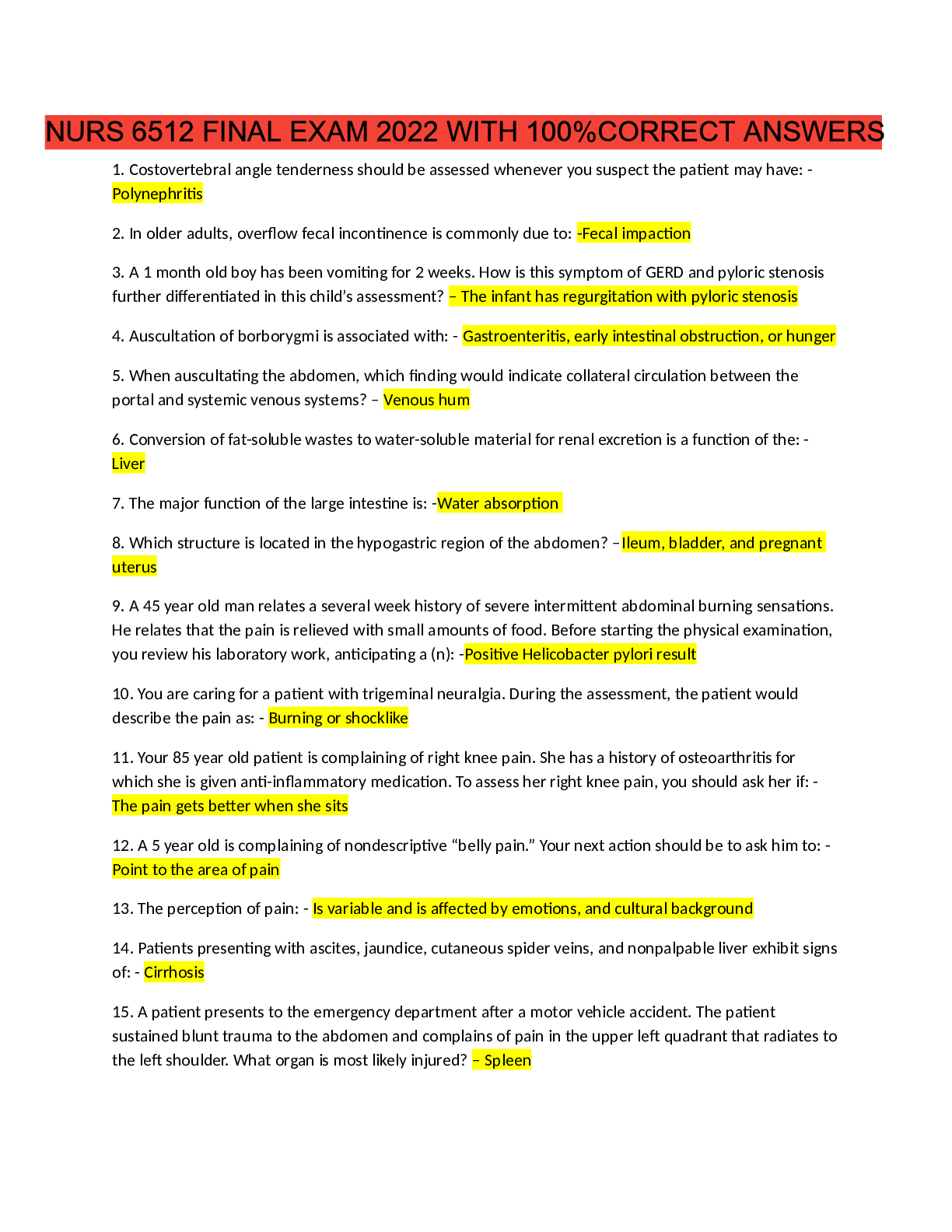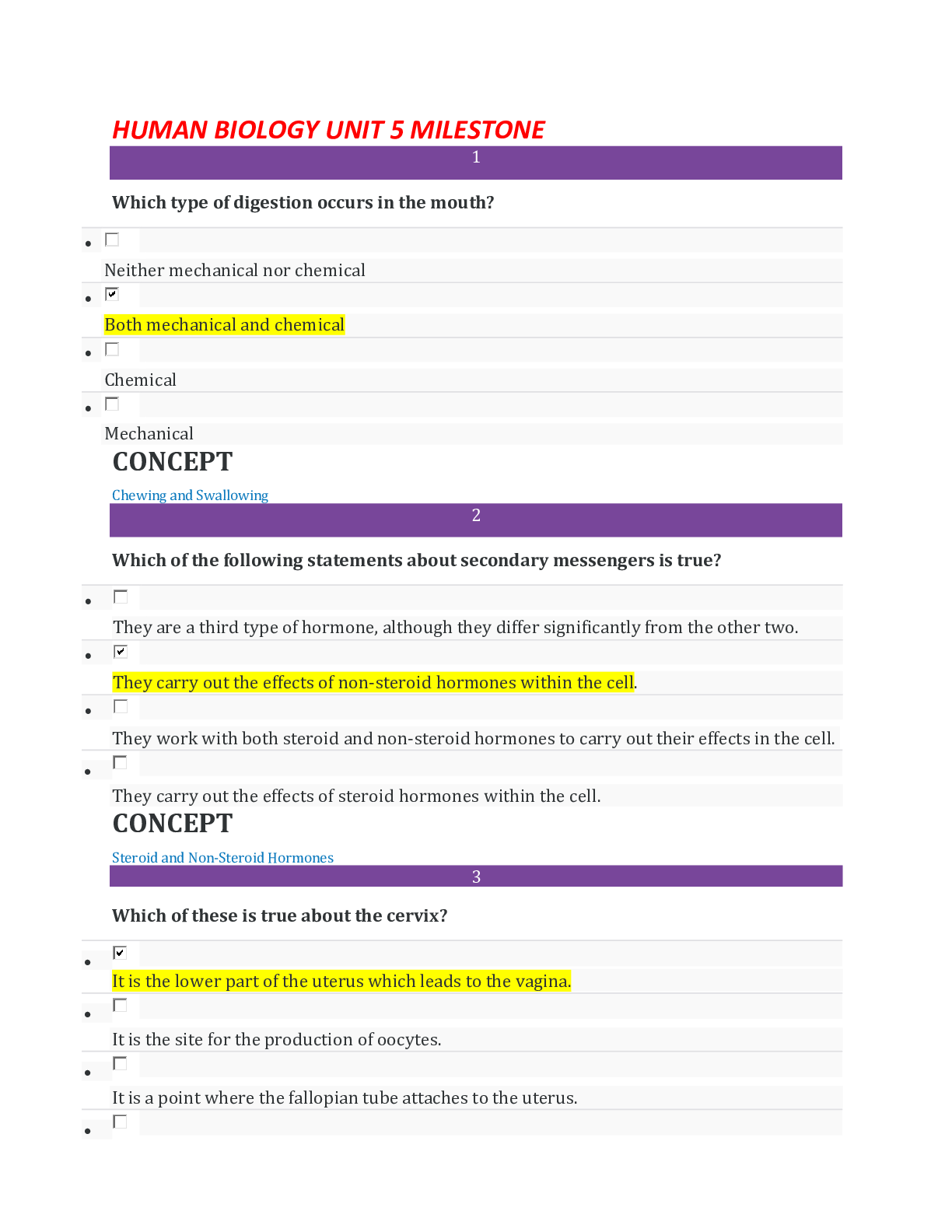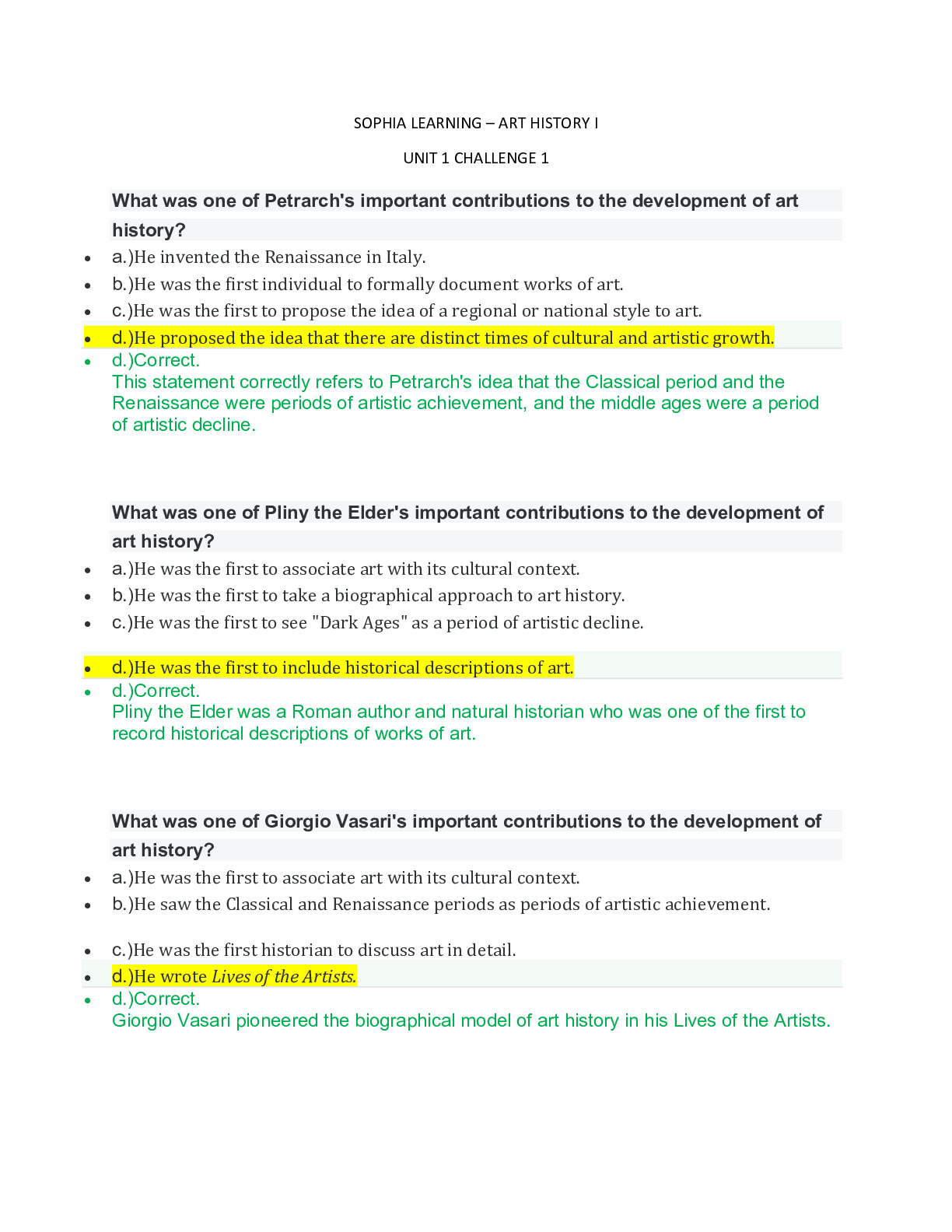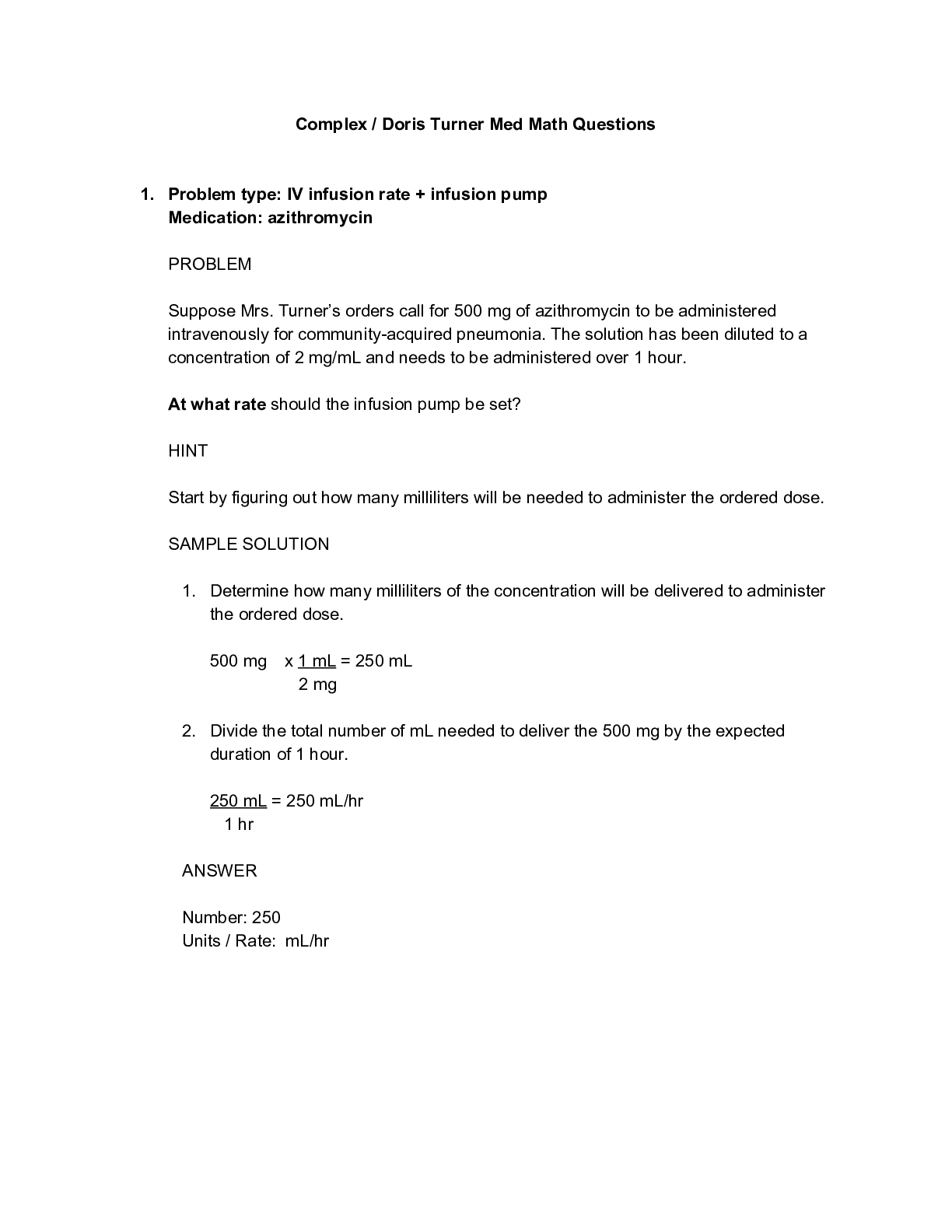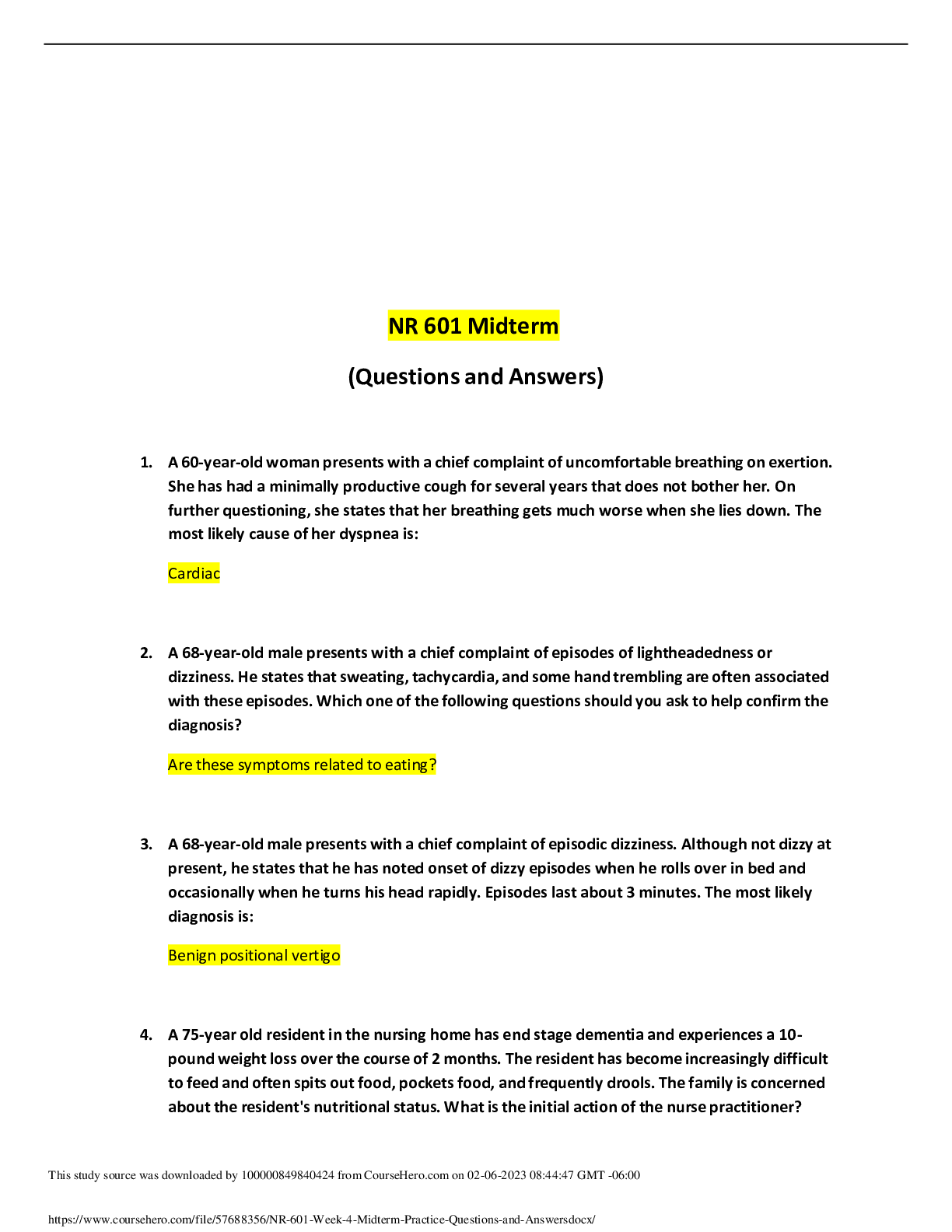NURS 325 Complex / Doris Turner Med Math Questions And Answers,100% CORRECT
Document Content and Description Below
NURS 325 Complex / Doris Turner Med Math Questions And Answers 1. Problem type: IV infusion rate + infusion pump Medication: azithromycin PROBLEM Suppose Mrs. Turner’s orders call for 500... mg of azithromycin to be administered intravenously for communityacquired pneumonia. The solution has been diluted to a concentration of 2 mg/mL and needs to be administered over 1 hour. At what rate should the infusion pump be set? HINT Start by figuring out how many milliliters will be needed to administer the ordered dose. SAMPLE SOLUTION 1. Determine how many milliliters of the concentration will be delivered to administer the ordered dose. 500 mg x 1 mL = 250 mL 2 mg 2. Divide the total number of mL needed to deliver the 500 mg by the expected duration of 1 hour. 250 mL = 250 mL/hr 1 hr ANSWER Number: 250 Units / Rate: mL/hr 2. Problem type: Dosage calculation + Stock on hand Medication: venlafaxine PROBLEM Mrs. Turner’s daily medications include venlafaxine extendedrelease, 150 mg, by mouth, once a day. However, the hospital pharmacy only carries 75 mg extendedrelease tablets. How many tablets of venlafaxine extendedrelease should be administered to her? HINT You can use the equation below, where X is the number of tablets that should be administered. D (ordered dose) x Quantity = X H (dose on hand) SAMPLE SOLUTION 1. Determine what information you have. D (ordered dose) = 150 mg H (dose on hand) = 75 mg Q (quantity) = 1 tablet 2. Plug into the equation and solve. D (150 mg) x 1 tablet = X H (75 mg) X = 2 tablets ANSWER Number: 2 Units: tablets 3. Problem type: Total daily dosage Medication: Acetaminophen @ hospital hypothetical Suppose Mrs. Turner’s provider updated her order for 325 mg, 2 tabs, by mouth q6h PRN temp. > 100.5 F to 325 mg, 2 tabs, by mouth q4h PRN temp. > 100.5 F. The Davis’s Drug Guide reports that acetaminophen has a maximum recommended dosage of 4 g/day. How many doses can Mrs. Turner take without exceeding the recommended maximum dosage? HINT There are 1000 mg in one gram. SAMPLE SOLUTION 1. Determine how many milligrams are in 4 grams. 4 g x 1000 mg = 4000 mg 1 g 2. Determine how many 325 mg tablets go into 4000 mg. 4000 mg x 1 tablet = 12.3 tablets 325 mg 3. Round down to the nearest whole tablet = 12 tablets 4. Divide the total number of tablets by the number tablets in a dose. 12 tablets total x 1 dose = 6 doses 2 tablets ANSWER Number: 6 Units: doses 4. Problem type: Total daily dose calculation Medication: acetaminophen @ hospital PROBLEM Suppose Mrs. Turner’s current temperature is 100.8 F. For temperatures greater than 100.5 F, the prescriber’s order allows acetaminophen, 325 mg, 2 tabs, by mouth, every 6 hours. Assume that on her first day of hospitalization, Mrs. Turner’s temperature is greater than 100.5 F three times. How many grams of acetaminophen will she have ingested on her first day of hospitalization? Round your answer to hundredths. HINT Multiply the number of taken doses by the number of tablets. SAMPLE SOLUTION 1. Multiply the number of doses taken by the number of tablets per dose. 3 doses x 2 tablets = 6 tablets 1 dose 2. Multiply the dosage of acetaminophen by the number of tablets. 6 tablets x 325 mg = 1950 mg 1 tablet 3. Convert the total daily milligrams to grams. 1950 mg x 1 g = 1.95 g 1000 mg ANSWER Number: 1.95 Units: g 5. Problem type: Dosage calculation + Stock on hand Medication: potassium chloride PROBLEM Mrs. Turner’s daily medications include potassium chloride, 10 mEq tablet by mouth once daily. The hospital pharmacy will dispense potassium chloride liquid 10% (1.5 gram or 20 mEq per 15 mL). The KCl liquid will be further diluted in a 6 oz glass of water or juice for administration. What volume of the KCl 10% liquid should be used for Mrs. Turner’s usual daily dose? HINT Multiply the desired dose by the concentration. SAMPLE SOLUTION 1. Multiply the desired dose by the concentration. 10 mEq x 15 mL = 7.5 mL of KCl 10% liquid day 20 mEq day ANSWER Number: 7.5 Units: mL / day 6. Problem type: IV flow + allergic reaction Medication: ceftriaxone hypothetical PROBLEM Mrs. Turner’s original orders called for ceftriaxone, 1g, to be administered intravenously daily. The solution has been diluted to a concentration of 1 g / 50 mL to be administered over 30 minutes. Twenty minutes into the first infusion, Mrs. Turner reports an adverse reaction to the antibiotic and the infusion is stopped. How many mL of concentration were administered before the infusion was stopped? Round your answer to the nearest whole number. HINT Divide the time elapsed by the infusion rate to determine the completion percentage of the infusion. SAMPLE SOLUTION 1. Determine the completion percentage of the infusion. 20 min (time elapsed) = 0.667 (or 66.7 %) 30 min (total infusion time) 2. Multiply the infusion volume by the percentage. 50 mL x 0.667 = X X = 33 mL ANSWER Number: 33 Units: mL 7. Problem type: Dosage calculation + weightbased dosage Medication: azithromycin @ hospital hypothetical According to the Davis’s Drug Guide, children sixmonthsold or younger with communityacquired pneumonia can be administered azithromycin orally using a weightbased dosage. Children in this age group can receive 10 mg/kg on the first day, then 5 mg/kg for four more days. Assume you need to administer this to a child weighing 20.3 lbs. What is the total dose of azithromycin the child will receive over five days? Round your answer to the nearest whole number. HINT Convert pounds to kilograms, and multiply the weight by the dosage. SAMPLE SOLUTION 1. Convert pounds (lbs) to kilograms (kg). 20.3 lbs x 1 kg = 9.227 kg 2.20 lb 2. Multiply the first day’s dosage by weight in kg. 10 mg x 9.227 kg = 92.27 mg kg 3. Multiply the dosage given for days 25 by weight in kg, and multiply by the number of days administered (4). 9.227 kg x 5 mg x 4 = 184.54 mg kg 4. Add the results from steps 2 and 3. 92.27 mg + 184.54 mg = 276.81 mg, rounded to 277 mg ANSWER Number: 277 mg Units: mg 8. Problem type: Unit conversation + stock on hand Medication: levothyroxine @ hospital Mrs. Turner’s orders called for 50 mcg of levothyroxine, by mouth, daily. The pharmacy stocks the medication in 0.025 mg tablets. How many tablets are needed to administer the ordered dose? HINT Start by converting 50 mcg to mg. Then use the equation below, where X is the number of tablets that should be administered. D (ordered dose) x Quantity = X H (dose on hand) SAMPLE SOLUTION 1. Convert micrograms (mcg) to milligrams (mg). 50 mcg x 1 mg = 0.05 mg 1000 mcg 2. Determine what information you have. D = 0.05 mg H = 0.025 mg Q = 1 tablet 3. Plug into the equation and solve. D (0.05 mg) x 1 tablet = X H (0.025 mg) X = 2 tablets ANSWER Number: 2 Units: tablets 9. Problem type: Total daily dose calculation Medication: Units of insulin @ home At home, Mrs. Turner takes 16 units of insulin aspart, twice a day with meals. She also takes 45 units of longacting insulin glargine, daily. How many total units of insulin does Mrs. Turner take daily? HINT Start by multiplying the dosage of insulin aspart by how often Mrs. Turner takes it. SAMPLE SOLUTION 1. Multiply the dosage by the number of units per dose. 16 units x 2 = 32 units 2. Add the total number of insulin aspart units and the total number of insulin glargine units. 32 units + 45 units = 77 units ANSWER Number: 77 Units: units 10. Problem type: Dosage calculation Medication: Insulin aspart @ hospital hypothetical The provider ordered insulin aspart on a sliding scale for 1 unit/10 g CHO subcutaneous + 1 unit/50 points above 150 BG. Mrs. Turner will eat a meal that contains 40 g CHO and has a premeal BG level of 160. How many units of insulin should be administered? HINT Add the units calculated from the sliding scale to the units necessary for the patient’s current BG level. SAMPLE SOLUTION 1. Perform the sliding scale calculation (1 unit/10g CHO). 40 g CHO x 1 unit = 4 units 10 g CHO 2. Subtract 150 from Mrs. Turner’s premeal BG. 160 BG 150 BG = 10 points 3. Multiply 10 points by the number of units per 50 points. 10 points x 1 unit = 0.2 units 50 points Round down to the next whole unit = 0 unit 4. Add the units from the sliding scale to the additional units needed for every 50 points above 150 BG. 4 units + 0 unit = 4 units ANSWER Number: 4 Units: units 11. Problem type: Unit conversion + orders correction Medication: levothyroxine @ hospital hypothetical Suppose Mrs. Turner’s provider writes a revised order of 25 mg of her daily levothyroxine. Given that her original order was in micrograms, you suspect this new order contains an error. You take the appropriate measures to get the orders corrected in order to avoid administering an overdose. If the error had not been caught, how many times more levothyroxine would have been given? HINT Start by converting 25 mg to micrograms. SAMPLE SOLUTION 1. Convert milligrams (mg) to micrograms (mcg). 25 mg x 1000 mcg = 25,000 mcg 1 mg 2. Divide the incorrect mcg dosage by correct mcg dosage. 25,000 mcg = 1000 25 mcg ANSWER Number: 1000 Units: times overdose 12. Problem type: IV flow rate + drop factor Medication: azithromycin @ hospital hypothetical Suppose Mrs. Turner’s provider orders 500 mg of azithromycin to be delivered in a 250 mL IV solution over 3 hours. The dose will be delivered using IV tubing with a drop factor of 15 (15 gtt (drops) = 1 mL) What is the appropriate rate of flow for the IV, in drops per minute? Round your answer to the nearest whole number. HINT Start by determining how many mL will be delivered per minute. SAMPLE SOLUTION 1. Divide the total number of mL needed to deliver the 500 mg dilution by the expected duration in minutes, converting hours to minutes. 250 mL x 1 hr = 1.389 mL/min 3 hr 60 min 2. Multiply the mL / min by the drop factor and round to the nearest whole number. 1.389 mL x 15 gtt = 20.8 gtt/min 1 min 1 mL 3. Round your answer to the nearest whole number. = 21 gtt / min ANSWER Number: 21 Units: gtt / min 13. Problem type: IV flow rate + drop factor Medication: azithromycin @ hospital hypothetical On the second day of hospitalization, Mrs. Turner’s orders call for 500 mg of azithromycin to be delivered in a 250 mL IV solution over 3 hours. The dose will be delivered using IV tubing with a drop factor of 10 (10 gtt (drops) = 1 mL). What is the appropriate rate of flow for the IV in drops per minute? Round your answer to the nearest whole number. HINT Start by determining how many mL will be delivered per minute. SAMPLE SOLUTION 1. Divide the total number of mL needed to deliver the 500 mg dilution by the expected duration, converting hours to minutes. 250 mL x 1 hr = 1.389 mL/min 3 hr 60 min 2. Multiply the mL / min by the drop factor and round to the nearest whole number. 1.389 mL x 10 gtt = 13.89 gtt / min 1 min 1 mL Round your answer to the nearest whole number = 14 gtt / min ANSWER Number: 14 Units: gtt / min 14. Problem type: Correct days’ supply Medication: Insulin @ primary care hypothetical Mrs. Turner is prescribed insulin aspart, 16 units, SC TID at mealtimes. When Mrs. Turner returns home, the provider would like to switch her mealtime insulin administration to a pen delivery device instead of insulin syringes. The provider will keep the same dose. Assume that Mrs. Turner eats three meals a day. If the pen cartridges contain 3 mL of U100 insulin aspart, how often will Doris need to replace the cartridge? Round your answer down to the nearest whole day. HINT U100 insulin contains 100 units / 1 mL. SAMPLE SOLUTION 1. Multiply the number of units by the number of meals each day. 16 units x 3 meals = 48 units of insulin aspart meal day day 2. Multiply the concentration of U100 insulin by the volume of a cartridge. 100 units x 3 mL = 300 units mL cartridge cartridge 3. Multiply the result from step 2 by the number of units per day, so that the units cancel. 300 units x 1 day = 6.25 days / cartridge, rounded to 6 days cartridge 48 units ANSWER Number: 6 Units: days 15. Problem type: Correct days’ supply Medication: Insulin @ primary care hypothetical Assume that Mrs .Turner’s provider decides to prescribe insulin aspart, 16 units SC TID at mealtimes, and Mrs. Turner receives a U100, 10 mL vial of insulin aspart. Assume that Mrs. Turner eats three meals a day. How long would a U100, 10 mL vial of insulin aspart last at this dosage? Round your down answer to the nearest whole day. HINT U100 insulin contains 100 units / 1 mL. SAMPLE SOLUTION 1. Multiply the number of units by the number of meals each day. 16 units x 3 meals = 48 units of insulin aspart meal day day 2. Multiply the concentration of U100 insulin by the volume of the vial. 100 units x 10 mL = 1000 units 1 mL vial vial 3. Multiply the result from step 2 by the number of units per day, so that the units cancel. 1000 units x 1 day = 20.8 days/vial, rounded down to 20 days Vial 48 units ANSWER Number: 20 Units: days [Show More]
Last updated: 1 year ago
Preview 1 out of 27 pages
Instant download
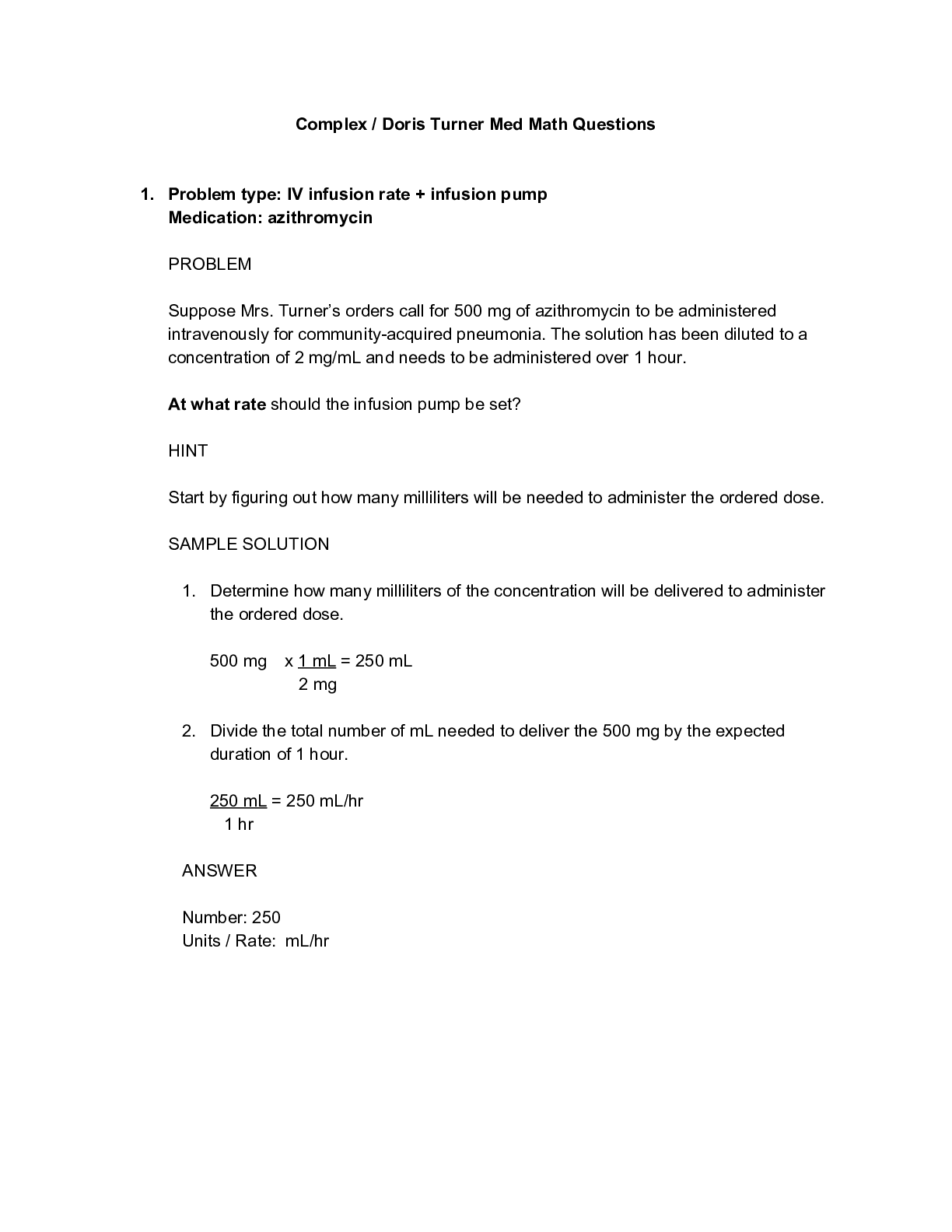
Buy this document to get the full access instantly
Instant Download Access after purchase
Add to cartInstant download
Reviews( 0 )
Document information
Connected school, study & course
About the document
Uploaded On
May 04, 2021
Number of pages
27
Written in
Additional information
This document has been written for:
Uploaded
May 04, 2021
Downloads
0
Views
95




